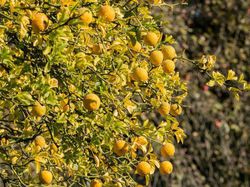 There is hardly any other plant that reflects the Mediterranean attitude to life as strongly as the lemon and citrus plants in general. Just think of the Amalfi lemons that grow along the Italian coast of the same name. If you also want to enjoy lemon plants north of the Alps, you have few options. On the one hand, you have to visit a botanical garden or grow your own container plants in your garden, with all the burdens and worries that it entails. For example, the correct and frost-free overwintering in a not too dark, but also not too warm place in the house or garage. And, of course, the regular repotting of the ever larger and bulkier lemon plants. Not to mention the annual cleaning and clearing out of the plants.
There is hardly any other plant that reflects the Mediterranean attitude to life as strongly as the lemon and citrus plants in general. Just think of the Amalfi lemons that grow along the Italian coast of the same name. If you also want to enjoy lemon plants north of the Alps, you have few options. On the one hand, you have to visit a botanical garden or grow your own container plants in your garden, with all the burdens and worries that it entails. For example, the correct and frost-free overwintering in a not too dark, but also not too warm place in the house or garage. And, of course, the regular repotting of the ever larger and bulkier lemon plants. Not to mention the annual cleaning and clearing out of the plants.
With our hardy Switrus® citrus young plants, all this is now a thing of the past, because they have been selected and tested for winter hardiness.
Advantages of the Switrus® range
Switrus® varieties and young plants are characterised by the following properties:
- Winter hardiness down to about -8 to -10°C for evergreen cultivars and species; depending on the variety, even lower
- Winter hardiness down to -20°C for deciduous varieties (Poncirus)
- A combination of usefulness and ornamental value
- Ungrafted young plants
The brand Switrus® is ultimately the abbreviation of 'Swiss Citrus'. Our sister company Lubera® has tested and selected these varieties in Switzerland. From the sifting of more than 50 hardy citrus selections, this assortment will be continuously expanded in the future.
Lemons and winter hardiness
With lemons, one always reads the most diverse information. One text says 'frost tolerant' and another text writes about 'frost hardiness'. Basically, the same characteristic is always described. Many citrus species and varieties have a natural tolerance to negative temperatures. Thus, as a rule, late spring frosts or early autumn frosts down to -2°C are not a big problem for most common cultivars and species. This is especially true for lemon varieties.
However, it is important to clarify here that the described tolerance to slightly negative temperatures has nothing to do with the intended winter hardiness of our Switrus® citrus young plants. The species and varieties we classify as Switrus® have a real winter hardiness, which means that the plants and especially the wood of the plants can cope with longer frosts and will sprout as usual in the spring. Of course, this winter hardiness gets better as the plants are older and have a stronger wooden core.
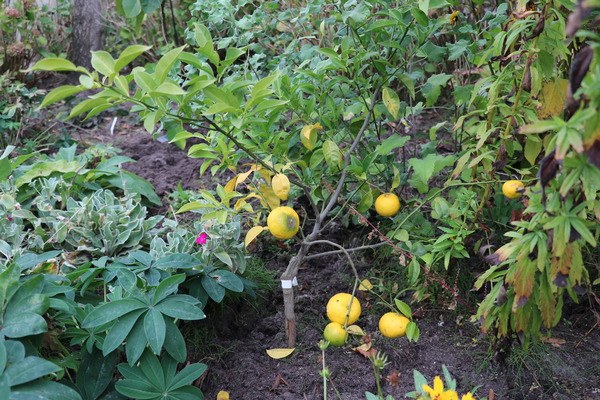
Picture: fresh planted Yuzu lemon at a protected site
This winter hardiness occurs naturally in some citrus species, as an adaptation and survival strategy in the respective natural ranges of each species. This is because not all citrus species grow in tropical or subtropical latitudes. For example, the natural distribution area of the trifoliate orange – Poncirus trifoliata – is in the area of influence of the Himalayas.
Hardy citrus plants in the home garden
The basic idea behind buying a hardy lemon plant is almost always the same: you want to have the exoticism of a lemon plant in your own garden with as little effort as possible. With this in mind, does it really make sense to cultivate a hardy citrus plant as a container plant? Everyone is welcome to answer this question for themselves.
Of course, all our Switrus® lemons can be cultivated as container plants. However, it is important to note that these potted plants must be treated in the same way as all other potted plants. They must be overwintered in a bright and frost-free but not too warm place. The difference is that you can take the plants out of their winter quarters earlier and they can stay outside longer in the autumn months.
Basically, it can be said that our hardy Switrus® lemons should be planted out. On the whole, almost any garden is suitable for our Switrus® lemons, but there will be differences in individual cases. As already mentioned above, a distinction should be made between evergreen and deciduous varieties/species when choosing a location.
Deciduous Switrus® citrus young plants
Among the deciduous Switrus® we currently only have the trifoliate orange – Poncirus trifoliata – and its varieties in our range of young citrus plants. The leaf fall of this genus in autumn is one of the best winter protection measures in the plant kingdom. Leaf fall also has the advantage that the leaves turn a bright yellow in autumn before they ultimately fall off. With a winter hardiness of -20°C and lower, the trifoliate orange is actually recommended for any garden location. Nevertheless, freshly planted plants should be protected from the strong winter sun for at least the first three winters.
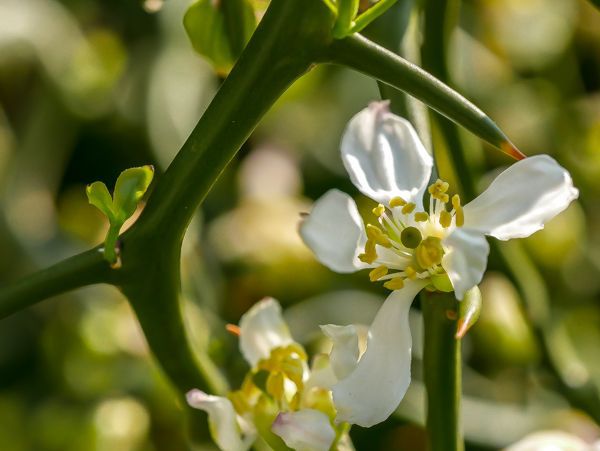
Picture: the deciduous trifoliate orange, the plant start flowering at the same time when the new leaves sprout
Evergreen Switrus® citrus young plants
With the evergreen Switrus® species and varieties, we currently have the Yuzu – Citrus x junos – in the citrus young plants assortment and the situation is somewhat different with regard to location. As mentioned above, the evergreen Switrus® are less winter hardy than the deciduous ones and therefore need a much milder location. Wine-growing regions or regions with a mild maritime climate are recommended. In individual cases, sheltered and fully sunny locations close to a house or a mild and sheltered patio are also recommended for evergreen Switrus®. Regardless of how mild a location is, it should always be in full sun and here it is then also important to protect the plants from too intense winter sun with a fleece or something comparable in the winter. Like all evergreen plants, the evergreen Switrus® is also susceptible to winter drought. It is therefore advisable to protect the root zone of the Switrus® from freezing completely through with a thick layer of foliage in autumn.
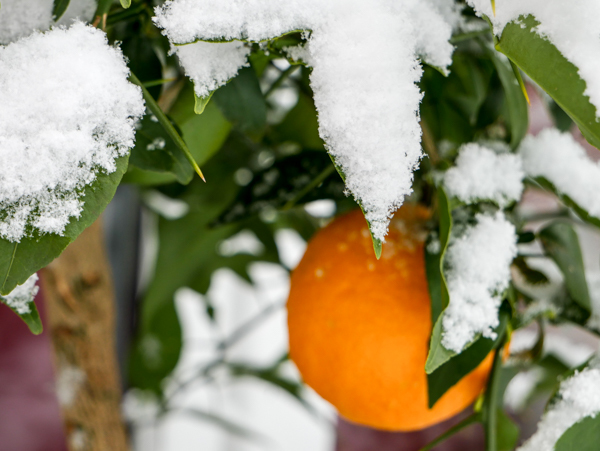
Picture: the hardy and evergreen yuzu lemon - lemons in the snow can probably only be seen north of the Alps.
Another possibility is to cultivate the evergreen Switrus® as a container plant for a few years until the plants have a sufficiently strong wooden core. Only then should they be planted out in the locations described above, also with the winter protection measures described.
Location and winter protection tips
Deciduous Switrus®
- A location in full sun, no other restrictions
- Provide winter protection from the winter sun for the first three years after planting
Evergreen Switrus®
- Mild location (wine-growing region, mild maritime climate)
- Needs a protected site (courtyard, close to a house)
- Full sun
- Winter protection is essential (shade from the winter sun)
- Cover the root area with a thick layer of leaves in autumn
- Cultivate the plants as container plants for the first 3-5 years and then plant them out (with all necessary winter protection measures)
Switrus® citrus young plants
Our young citrus plants, which we sell under the Switrus® brand, are hardy citrus species that are very suitable for growing in the home garden. As a standard, we deliver our young plants in our 60-cell tray. All of the young plants offered are not grafted, but grow on their own roots. Our established production process ensures that we can offer our customers very uniform and vigorous young plants. Due to the pronounced vegetative growth in the cultivation and in the later finished product production, a beautiful, bushy finished product is achieved. However, it takes between three and five years from propagation to flowering. Every repotting and every winter shortens this juvenile phase and finally the plant starts into its generative growth phase, during which it begins to flower and produce fruit.
The deciduous varieties in the Switrus® citrus young plants range
Poncirus trifoliata – the trifoliate orange
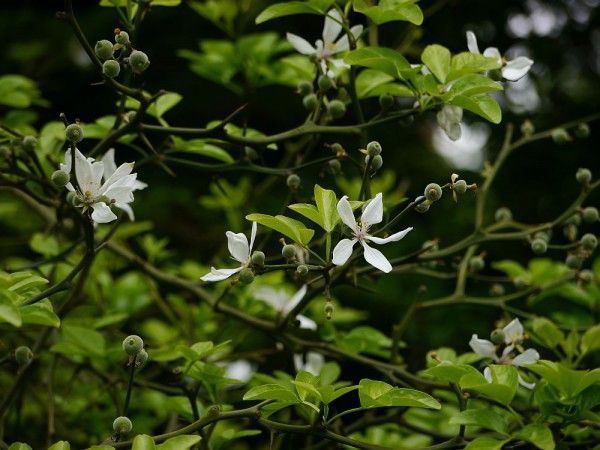
Picture: flowering Poncirus plant with young fruits
The trifoliate orange, sometimes also called bitter orange or hardy orange, is the citrus young plant with the highest winter hardiness. Winter temperatures of -20°C and lower are easily withstood by this species. Botanically, it is not a true citrus species, but the genus Poncirus is very closely related to the genus Citrus. That is why it is mentioned here.
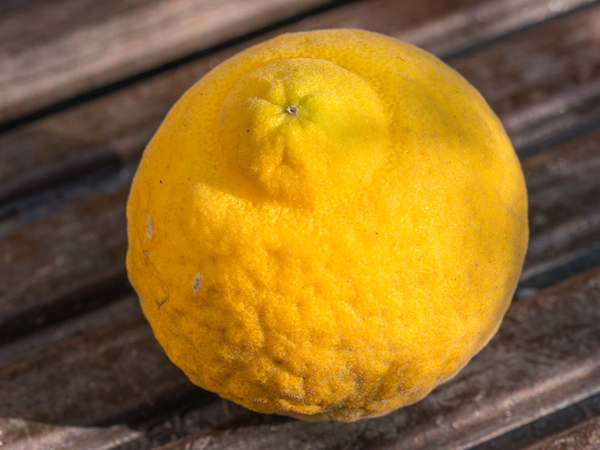
Picture: ripe Poncirus fruit
In terms of fruit, the trifoliate orange is a purely processed fruit. As the synonym 'bitter orange' suggests, the fruit is very bitter all in all. In addition, there are relatively many seeds and resinous oils in the skin of the fruit. When made into marmalade, the result is very reminiscent of the English orange marmalade made from Citrus aurantium, but even more bitter.
To make marmalade, the fruit is largely freed from the peel, cut into pieces, boiled down with a little water and then cooked with the same amount of preserving sugar to make marmalade.
From a horticultural point of view, the trifoliate orange is also a noteworthy grafting rootstock, precisely because of its pronounced winter hardiness.
Short description:
- Growth: sparse growth with long thorns; deciduous with bright yellow autumn colouring
- Flowers: bloom at the same time as the leaves; citrus-like flowers, but larger and more attractive with an intense fragrance
- Fruits: about 5 cm large, orange-like fruits; when fully ripe, the fruits shine in an intense yellow; the fruits fall off by themselves when ripe – around November
- Winter hardiness: once established in their location, the plants are extremely hardy – down to -20°C and lower; in the first few winters, light winter protection, especially against the intense winter sun, is recommended
- Use: For processing into bitter orange jam (not to be confused with the English original), the dried fruits are also used as a spice
'Flying Dragon' (Poncirus trifoliata) – Twisted trifoliate orange
This is a very striking variety of the trifoliate orange. With its bizarre and twisted growing shoots, this variety is a real eye-catcher in any garden. With a relatively weak growth, Poncirus 'Flying Dragon' is also well suited for small gardens. In the flowering period, the attractiveness of this variety’s flowers hardly differs from the actual species. The same applies to the fruit size, the ripening time and the use of the fruits.
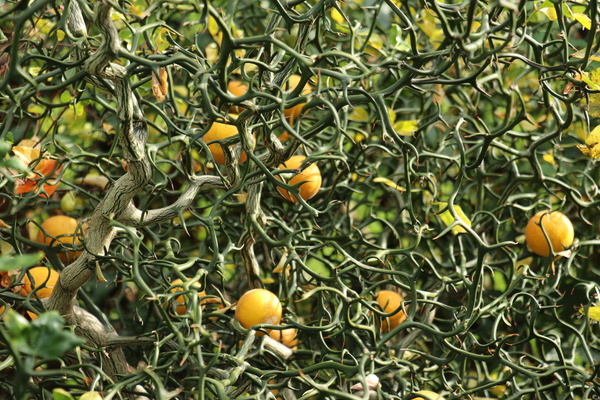
Picture: Ornamental trifoliate orange - 'Flying Dragon' with corkscrew-like twisted growing shoots
Short description:
- Growth: rather weak-growing (250 cm at the age of 10 years); bizarre, twisted growth, long thorns on the shoots; deciduous with bright yellow autumn colouring
- Flowers: bloom at the same time as the leaves; citrus-like flowers, but larger and more attractive with an intense fragrance
- Fruits: about 5 cm large, orange-like fruits; when fully ripe, the fruits shine in an intense yellow; the fruits fall off by themselves when ripe – around November
- Winter hardiness: once established in their location, the plants are extremely hardy – down to -20°C and lower; in the first few winters, light winter protection, especially against the intense winter sun, is recommended
- Uses: For processing into bitter orange jam (not to be confused with the English original), the dried fruits are also used as a spice
The evergreen varieties in the Switrus® citrus young plants assortment
Citrus x junos – Yuzu lemon
The Yuzu lemon (Citrus x junos) with its relative winter hardiness of about -9°C (lower temperatures are also possible for short periods) is the best compromise between winter hardiness and fruit quality in our current citrus young plant assortment. The winter hardiness of this species goes back to the genetic lineage; the Yuzu lemon originated from a cross between Citrus ichangensis x Citrus reticulata var. austera (Ichang lemon x mandarin orange). Both species have a certain frost hardiness by nature; with the Ichang lemon, one can already speak of winter hardiness.
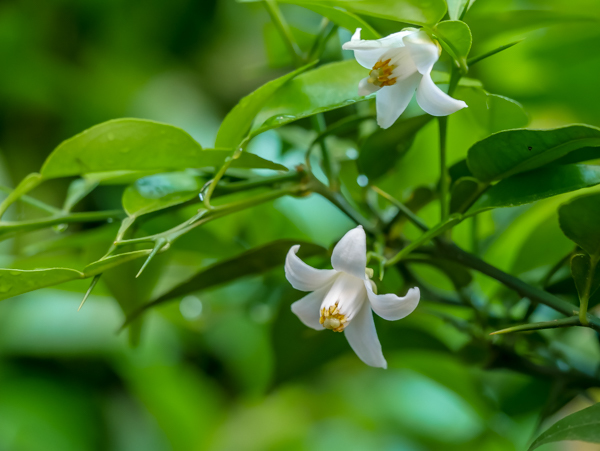
Picture: flowering Yuzu lemon
In China, the Yuzu lemon has been cultivated since ancient times and in Japan this species has also been cultivated for at least 1,000 years. In traditional Chinese and Japanese cuisine, it is mainly the fruit peel of the Yuzu lemon that is used, as the fruit peel is very rich in essential oils. Precisely because of this property, the Yuzu is also used a lot in the perfume industry.
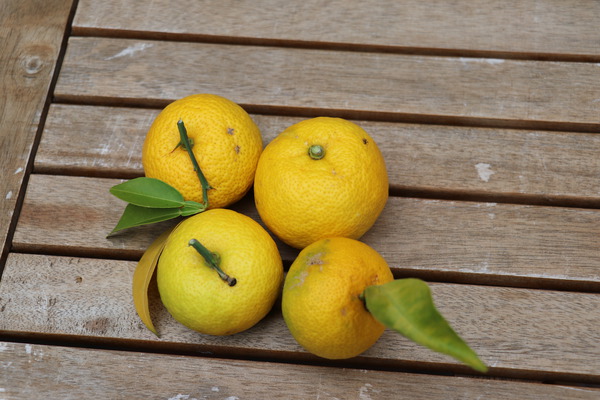
Picture: ripe fruits of the Yuzu lemon
For some years now, the Yuzu lemon has also found its way into international gastronomy, especially into upscale cuisine. In addition to the highly aromatic peel, the juice of the Yuzu fruit is often used in western gastronomy in general and especially in 'haute cuisine'. The fruits are basically very juicy and the juice is similarly acidic to that of a normal lemon. However, and this is why the Yuzu lemon is so popular in gastronomy, the taste is much more complex compared to a conventional lemon and the taste is made even more interesting by a subtle bitter note.
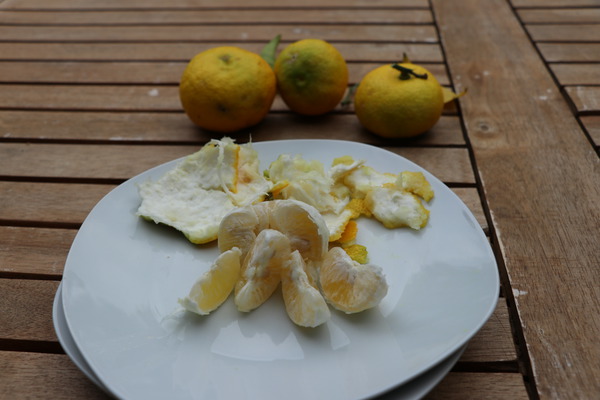
Picture: Tasting the ripe Yuzu fruits - besides the sour and fine-aromatic juice, the fruit peel can also be used to flavour dishes.
Short description:
- Growth: medium-strong growth, the conspicuously fine leaves have a pointed, elliptical shape; the Yuzu lemon is evergreen and armed with thorns on the leaf axils
- Fruits: flat, round shape; in the original distribution areas the fruits change colour from green to yellow to light orange; in Central Europe the fruits tend to remain green with a slight yellow tinge
- Winter hardiness: hardy down to -10°C, therefore mainly suitable for milder climates (wine-growing regions) or in a sheltered courtyard with a suitable microclimate; protection from too intense winter sun is nevertheless advisable
- Use: both the peel and the juice can be used in cooking; the peel is used for flavouring and the juice is used like conventional lemon juice, but its taste is much more complex and intense
More blog posts on citrus young plants
Read our other blog posts on the subject of citrus young plants:
- Lubera® Citrobella® - the simple citrus assortment for container cultivation – robust, but not hardy
- Production of citrus plants from Lubera Edibles citrus young plants
